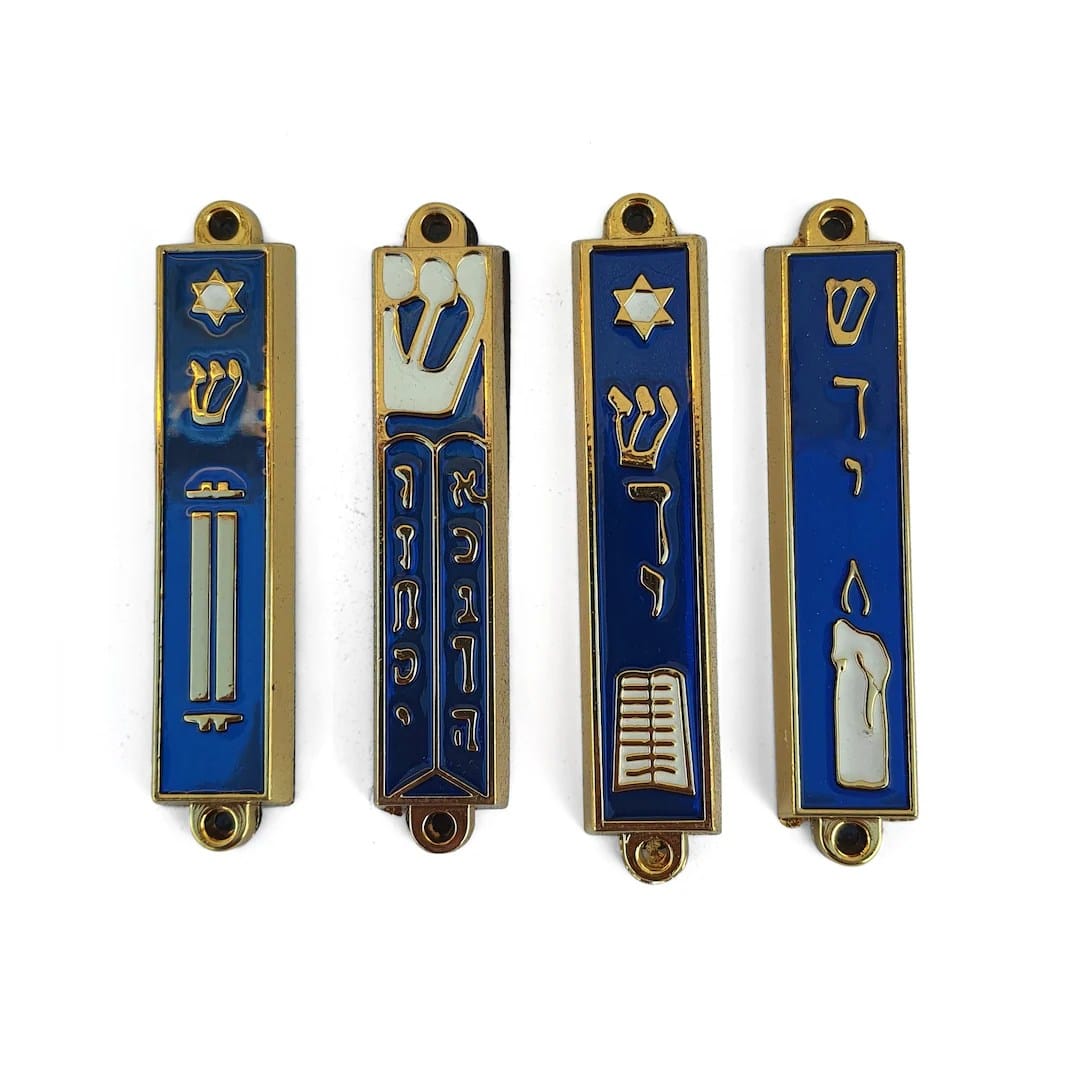Unlocking the Meaning: A Closer Look at the Mezuzah
You’ve probably seen them – those small, often ornate cases on doorposts in Jewish homes and offices. These are mezuzahs (pronounced “me-zoo-zahs”), and they hold deep meaning and tradition within Jewish culture. More than just decorations, they represent a tangible connection to faith and heritage.
Think of a mezuzah as a tiny treasure chest. But instead of gold or jewels, it holds something even more precious: a handwritten scroll containing verses from the Shema prayer, a central prayer in Judaism.
Why the Shema? This powerful prayer speaks about loving and remembering God. Having it written down and placed on the doorpost acts as a constant reminder – every time someone enters or leaves the room, they are reminded of their faith.
What Lies Within: The Components of a Mezuzah
Let’s take a peek inside:
The Scroll (Klaf): This is the heart of the mezuzah. It’s not just any piece of paper; it must be specially prepared parchment, and the verses are meticulously written by a trained scribe – someone dedicated to writing Hebrew scriptures with perfect calligraphy and special ink. A unique detail lies on the back – the Hebrew letter “Shin”, representing God’s name.
The Case: This protective shell safeguards the scroll from dust, weather, and wear and tear. Mezuzah cases are available in a stunning array of designs, from simple and elegant to artistic and modern. This is where individuals can express their personal style while honoring tradition.
Where and How: The Significance of Placement
Placement matters when it comes to a mezuzah. Traditionally, it is placed on the right side of the doorpost (as you enter the room), about a third of the way down from the top. It is also customary to angle it slightly inwards, towards the room.
A special blessing is recited when the mezuzah is put up. This blessing is like a dedication, asking for God’s presence and protection within the home.
A Gesture of Respect: Why People Touch the Mezuzah
You might see people touch or kiss their fingers after touching the mezuzah as they walk by. It’s a gesture of respect and a way to connect with the prayer inside.
More Than Just a Decoration: Layers of Meaning
While a mezuzah is a beautiful object, its significance extends far beyond aesthetics. Here are a few layers of meaning:
- God’s Presence: It serves as a tangible representation of God’s presence and protection within the home.
- A Covenant Reminder: It symbolizes the special relationship between God and the Jewish people.
- Spiritual Awareness: In a busy world, it serves as a gentle reminder of one’s faith and spiritual side.
Mezuzahs in the Modern World
The mezuzah has been around for centuries, but its meaning continues to evolve.
- Interfaith Families: In interfaith households, the mezuzah can spark important conversations about faith and tradition.
- Secular Jewish Homes: Even for those who don’t consider themselves strictly religious, the mezuzah can be a way to connect with cultural heritage and identity.
- Modern Designs: Today, you can find mezuzah cases that incorporate contemporary art, different materials, and personalized touches, making it a meaningful and stylish addition to any home.
Outperforming the Competition: What is a Mezuzah and What is Its Purpose?
Recommended Titles (Provide Competitor Titles for Analysis): To suggest the most effective titles, please provide the trending article titles from your competitors. I will analyze them and propose three optimized options.
Powerful Key Lines:
- More Than a Decoration: A mezuzah is a physical manifestation of Jewish faith, transforming a house into a home imbued with holiness and connection to God.
- Ancient Words, Everyday Reminder: Containing verses from the Shema prayer, the mezuzah serves as a constant reminder of the covenant between God and the Jewish people every time one enters or exits.
- Public Declaration, Private Connection: Affixed to the doorpost, the mezuzah acts as a visible symbol of Jewish identity to the outside world and a source of spiritual grounding for those within.
- From Exodus to Every Home: Echoing the lamb’s blood that marked Jewish homes during the Passover plague, the mezuzah continues to offer a sense of protection and divine presence.
Important Details for Your Article:
I. What is a Mezuzah?
- Physical Description:
- A small parchment scroll inscribed with specific Hebrew verses from the Torah (Deuteronomy 6:4–9 and 11:13–21).
- The verses form part of the Shema prayer, a central prayer in Judaism.
- The parchment is handwritten by a qualified scribe.
- The scroll is rolled up and placed inside a decorative case.
- The case is then affixed to the right doorpost of Jewish homes.
- Etymology:
- The word “mezuzah” is Hebrew for “doorpost.”
II. What is the Purpose of a Mezuzah?
- Religious Significance:
- Covenant Reminder: Serves as a constant visual and spiritual reminder of the covenant between God and the Jewish people.
- Shema Observance: Fulfills the mitzvah (commandment) to inscribe the words of the Shema “on the doorposts of your house” (Deuteronomy 6:9).
- Sanctification of the Home: Transforms the house into a Jewish home, infused with holiness and a connection to God.
- Cultural Significance:
- Jewish Identity: Acts as a public declaration of Jewish faith and a marker of Jewish identity.
- Connection to Tradition: Represents a tangible link to Jewish history, tradition, and the Exodus from Egypt.
- Personal Significance:
- Spiritual Protection: Many believe the mezuzah offers spiritual protection to the home and those within.
- Source of Inspiration: Can serve as a source of inspiration, comfort, and connection to faith in daily life.
III. Placement and Practices
- Placement:
- Traditionally placed on the right doorpost of the main entrance.
- Also placed on the doorposts of interior rooms (excluding bathrooms).
- The exact angle of placement varies according to different customs.
- Rituals:
- Affixing the Mezuzah: Usually done by a rabbi or knowledgeable individual who recites a blessing.
- Touching the Mezuzah: Upon entering or leaving, many Jews touch the mezuzah with their fingers and then kiss their fingers as a sign of respect.
IV. Historical Context
- Biblical Origins: The commandment to affix a mezuzah to the doorpost originates in the Torah (Deuteronomy 6:4-9, 11:13-21).
- Exodus Connection: The mezuzah is linked to the Passover story, where lamb’s blood on doorposts marked Jewish homes to be spared from the plague of the firstborn.
Unique Insights & Untapped Potential:
- Modern Interpretations: Explore how the meaning and significance of the mezuzah are interpreted in contemporary Jewish life.
- Artistic Expression: Discuss the wide variety of mezuzah cases, from simple to ornate, reflecting personal style, artistic trends, and cultural influences.
- Interfaith Dialogue: Consider addressing the mezuzah’s meaning for interfaith families or those exploring Jewish traditions.
By incorporating these elements and conducting further research based on competitor titles, you will be well-equipped to create a comprehensive and engaging SEO article that surpasses the competition.
Can a Woman Put Up a Mezuzah? Decoding the Tradition
The question of whether a woman can hang a mezuzah is a common one, often shrouded in misconceptions. Here’s a clear explanation based on Jewish law (Halakha):
The Short Answer: Yes, Absolutely
The prevailing halachic consensus is that Jewish women are not only permitted but obligated to put up a mezuzah, just like men. This obligation stems from the understanding that the mitzvah (commandment) of mezuzah applies to every Jewish dwelling, regardless of the homeowner’s gender.
Addressing Differing Opinions
While the majority of Jewish legal authorities (Poskim) agree on a woman’s obligation, there are differing opinions. Some, such as those cited in Tshuvos Vhanhagos 4:238:6, suggest it’s preferable for a man to perform the act. This stems from women not being obligated to write a mezuzah scroll.
However, this is not the widely accepted view. Prominent scholars like the Rambam (Maimonides) clearly state women are equally obligated to fulfill the mitzvah.
A Woman’s Place: Fulfilling the Mitzvah
When a woman hangs a mezuzah, she actively participates in a crucial Jewish tradition. She can and should recite the appropriate blessing, emphasizing her direct fulfillment of the mitzvah.
Beyond Hanging: The Deeper Significance
Understanding a woman’s role in hanging a mezuzah reveals a broader truth: women play a vital role in creating and sanctifying a Jewish home. Their participation in this mitzvah is not merely allowed but encouraged and valued.
Unlocking the Mystery: Why is a Mezuzah Slanted on a Door?
The slanted mezuzah: a seemingly simple detail that has sparked centuries of debate and interpretation within Jewish tradition. Why the slant? Let’s explore the fascinating reasons behind this practice.
A Tale of Two Traditions: Ashkenazi vs. Sephardic
The angle of the mezuzah is one of the most visible distinctions between Ashkenazi (Eastern European Jewish descent) and Sephardic (Spanish or Portuguese Jewish descent) customs.
- Ashkenazi Tradition: Typically place the mezuzah at a slant.
- Sephardic Tradition: Generally affix it vertically.
Unraveling the Ashkenazi Perspective
Several explanations exist for the slanted mezuzah within Ashkenazi communities:
- The Compromise Theory: One prominent view posits that the slant is a compromise between two opinions in the Talmud regarding vertical or horizontal placement. The slant symbolizes finding middle ground between differing viewpoints.
- Rashi’s Visibility Argument: Rabbi Shlomo Yitzchaki (Rashi), an influential medieval scholar, suggested the slant makes the mezuzah more visible upon entering, prompting a moment of acknowledgment and remembrance.
Understanding the Sephardic Reasoning
Sephardic Jews typically follow the rulings of Maimonides (Rambam), who interpreted Jewish law to prescribe a vertical placement. This interpretation emphasizes adhering to the literal instructions found within religious texts.
Symbolism Beyond the Angle
Regardless of the specific placement, the mezuzah holds profound meaning:
- Divine Protection: It serves as a symbolic shield, reminding those who dwell within of God’s protection.
- Connection to the Divine: The mezuzah’s presence is a constant reminder of God’s presence in their lives.
- Jewish Identity: It is a proud declaration of faith and heritage for the outside world to see.
A Conversation Starter
The angle of the mezuzah provides an excellent example of the dynamism within Jewish tradition. It sparks conversations about interpreting religious law, respecting diverse customs, and finding meaning in seemingly small details. Ultimately, the most important aspect is the act of fulfilling the mitzvah with intention and reverence.
- Unlock Elemental 2 Secrets: Actionable Insights Now - April 2, 2025
- Lot’s Wife’s Name: Unveiling the Mystery of Sodom’s Fall - April 2, 2025
- Photocell Sensors: A Complete Guide for Selection and Implementation - April 2, 2025
















